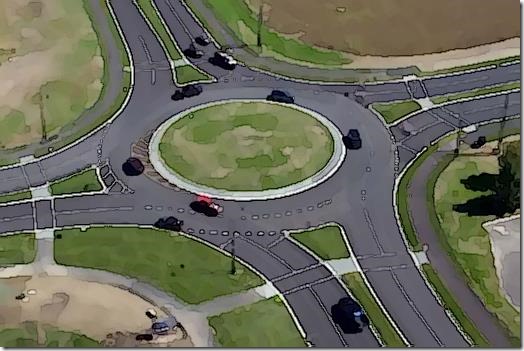I saw this topic on a forum recently. It concerns emerging – usually on to a roundabout – using a vehicle on your right as a “shield”. I’ve covered roundabouts in detail before, but this is a separate subject.
There is no official guidance that I am aware of which says you should or shouldn’t do it. I have to be honest and admit that I do it myself sometimes, but only if I am confident that I’m not taking too big a risk. Because it IS a risk, and doing it right depends heavily on how well you can control the car – being able to accelerate briskly, and to brake quickly and effectively if the situation changes – and on how well you can read other people. Most new drivers do not have those skills, and this should guide their decision about whether or not to do it.
So, what are the risks? Well, imagine that you’re sitting at the entrance to a roundabout in the left hand lane, and that there is a van to your right. The van is blocking your view of traffic coming from the right. Suddenly, the van moves off, and you follow suit. If everything goes to plan, you drive merrily on your way and everyone is happy. But consider the following possibilities:
- The van driver made the wrong decision and a bus or lorry was coming from the right. The bus/lorry collides with the van and pushes it into you, or the van sees the bus/lorry and realises he’s made a mistake, then takes evasive action by turning into your path.
- The van driver made the wrong decision because something was coming, and brakes sharply. You continue ahead and are suddenly exposed to whatever it is that made the van brake.
- The van moves off, but something was coming. The van manages to get away, but you move off a fraction of a second later – perhaps jumping a little as you rush the manoeuvre, thus slowing you down a bit more – and are exposed to whatever the van was trying to beat.
- The van moves off, but he was timing his move because there was something coming. You accelerate ahead and are exposed to whatever the van was waiting for.
- The van stops. You also manage to stop, but the car behind you had tried to move off with you and doesn’t react in time. He drives straight into the back of you and pushes you further on to the roundabout.
The simple fact is that no matter how well it turns out, you were simply guessing that the road was clear, and in the case of using a van as your shield were relying on someone who almost by definition was not the best example to follow. The examples above CAN happen.
Now, if the vehicle you’re using as a shield is bigger – a bus or a lorry, for example – it is likely to move off more slowly, and that means you can do the same. If it stops, you’ll have more time to react. Generally speaking, buses are less likely to take risks compared with van drivers, and lorries are less likely to be pushed into your path if someone collides with them. But even so, this is a mercenary view of a situation which still boils down to you taking a gamble on something you can’t see.
You cannot be certain how quickly or slowly your shield is going to move. Some lorries (e.g. motorway maintenance ones or those that often carry earth or rubble for building sites) can move off very quickly, especially if they’re unladen. Some vans – in spite of always adopting the “fast” lane as their default – move away extremely slowly (usually the old smelly DAF vans, or old rust buckets). If you can read this it definitely helps you make your decision. Oh, and consider which route you intend to take – if you’re going straight ahead, using a shield makes a lot more sense than if you’re simply turning left. Using a shield for left turns is roughly equivalent to trying to do roundabouts wearing a blindfold!
I always teach my learners that if they can’t see, then they shouldn’t go. Early on in their training they can easily be led by what other drivers are doing, and I often have to warn them “don’t copy him – wait until you can see” as they start to move off whilst completely unsighted (and sometimes in the wrong gear). Later on, I explain that using a shield during normal driving is only even passably acceptable if you’re bloody sure about what you’re doing. Don’t copy cars (especially Audis and BMWs, which are faster than you, and are driven by bigger idiots), and be very careful with vans (the drivers of which probably own Audis or BMWs anyway). And yes, I use that sort of language to get the message across.